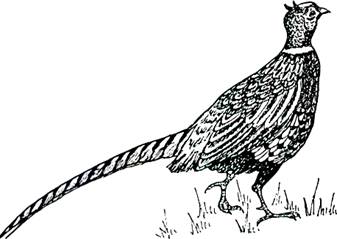Common Birds
Ring-necked Pheasant
 The Ring-necked Pheasant, which is popular as a game bird in the Midwest and Great Plaines, was first introduced into the United States via California in 1857. Large numbers were later released in Oregon throughout the 1880’s. The species has done very well in the Northern states as well as Canada. This hearty bird weighs from two to three pounds and can withstand rigorous winters as long as it can find a food supply. It seems those ice storms and deep crusty snow, which prevent them from reaching waste grain in our farm fields, are their greatest wintertime enemies. The various state DNR Officials and State Game Commissions regulate the hunting seasons according to the number of birds available. Because of their size and strength, the Pheasant can survive conditions that would wipe out the smaller bobwhite Quail. These birds are normally ground nesters and this years heavy and frequent rains are believed to have affected their survival rate. Experience suggests that a year or two of good nesting conditions will restore them to a normal population.
The Ring-necked Pheasant, which is popular as a game bird in the Midwest and Great Plaines, was first introduced into the United States via California in 1857. Large numbers were later released in Oregon throughout the 1880’s. The species has done very well in the Northern states as well as Canada. This hearty bird weighs from two to three pounds and can withstand rigorous winters as long as it can find a food supply. It seems those ice storms and deep crusty snow, which prevent them from reaching waste grain in our farm fields, are their greatest wintertime enemies. The various state DNR Officials and State Game Commissions regulate the hunting seasons according to the number of birds available. Because of their size and strength, the Pheasant can survive conditions that would wipe out the smaller bobwhite Quail. These birds are normally ground nesters and this years heavy and frequent rains are believed to have affected their survival rate. Experience suggests that a year or two of good nesting conditions will restore them to a normal population.
In the winter, Pheasants seem to flock up according to sex. These flocks can range from just a few to sometimes hundreds. But the average is more like a dozen to thirty or forty. The males are reasonably cordial towards one another until February or March when the competition for territory starts in earnest with the breeding and nesting starting in April and May. First year males are not much competition to the more mature males, and, if they don’t display and remain quiet, they are tolerated in a dominant male’s defended territory. These districts range from three to nine acres with the older, more aggressive males, seeming to command the larger areas. The territory defense by the male starts with a lot of crowing and wing flapping. Their crowing sounds a bit like a young Bantam Rooster just learning the art. The display toward the hen includes tail fanning and the dropping of a wing as he approaches her.
Natural enemies, besides the weather, are nest predators such as raccoons, skunks, possum, even white tail deer, who will all feed on the eggs and new born chicks. Fox and Coyotes will take chicks as well as inattentive adults. Feral and free roaming cats undoubtedly do the most harm to pheasant populations. And despite the common belief of hunters, hawks and owls have very little impact on over-all pheasant populations. However, Red-tailed hawks and owls are still persecuted because of this misconception. But as many Pheasants as our native predators take, it doesn’t compare to severe weather and free roaming cats. Many non- profit organizations are fighting hard to maintain habitat and food supplies for these splendid birds, which in turn helps all bird species.
Contributed by Mr. Weir Nelson of Wildlife Habitat, Cedar Rapids, Iowa
Published by The Wild Bird Habitat Store
